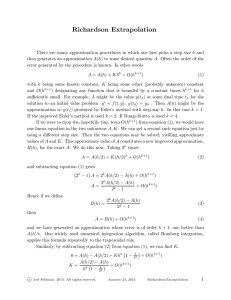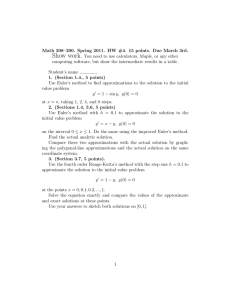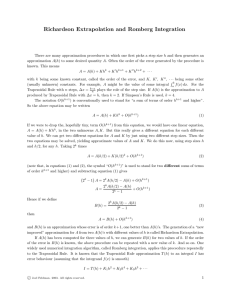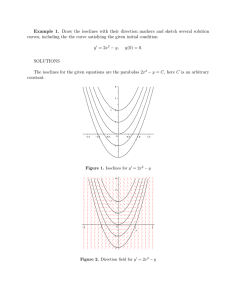Richardson Extrapolation
advertisement
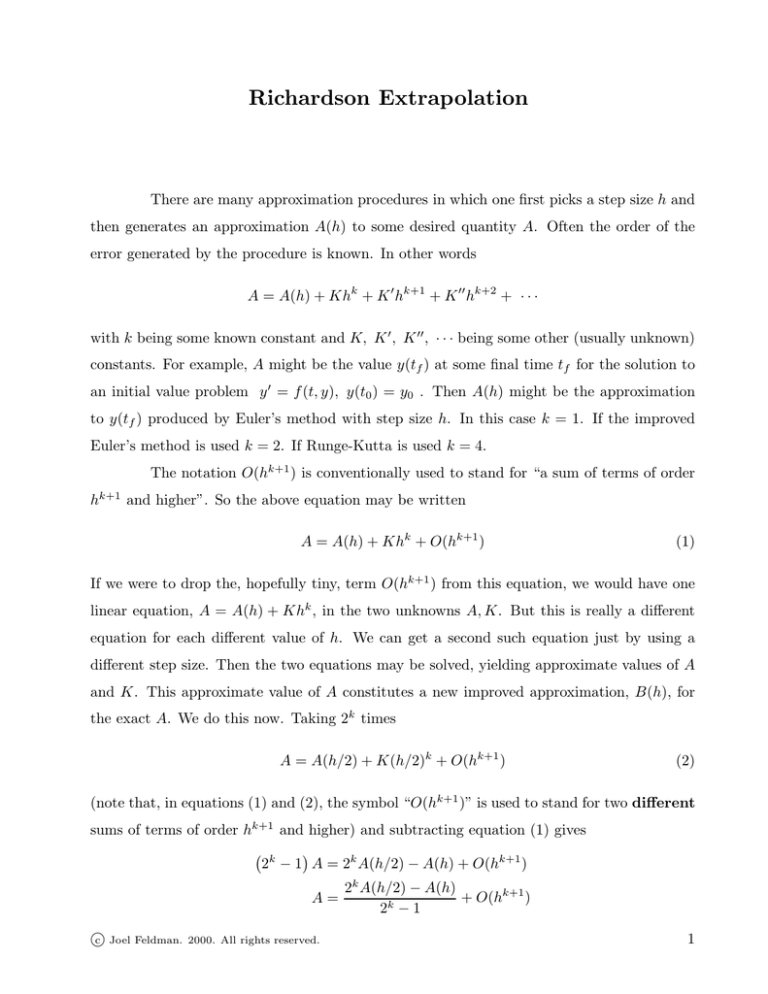
Richardson Extrapolation There are many approximation procedures in which one first picks a step size h and then generates an approximation A(h) to some desired quantity A. Often the order of the error generated by the procedure is known. In other words A = A(h) + Khk + K ′ hk+1 + K ′′ hk+2 + · · · with k being some known constant and K, K ′ , K ′′ , · · · being some other (usually unknown) constants. For example, A might be the value y(tf ) at some final time tf for the solution to an initial value problem y ′ = f (t, y), y(t0 ) = y0 . Then A(h) might be the approximation to y(tf ) produced by Euler’s method with step size h. In this case k = 1. If the improved Euler’s method is used k = 2. If Runge-Kutta is used k = 4. The notation O(hk+1 ) is conventionally used to stand for “a sum of terms of order hk+1 and higher”. So the above equation may be written A = A(h) + Khk + O(hk+1 ) (1) If we were to drop the, hopefully tiny, term O(hk+1 ) from this equation, we would have one linear equation, A = A(h) + Khk , in the two unknowns A, K. But this is really a different equation for each different value of h. We can get a second such equation just by using a different step size. Then the two equations may be solved, yielding approximate values of A and K. This approximate value of A constitutes a new improved approximation, B(h), for the exact A. We do this now. Taking 2k times A = A(h/2) + K(h/2)k + O(hk+1 ) (2) (note that, in equations (1) and (2), the symbol “O(hk+1 )” is used to stand for two different sums of terms of order hk+1 and higher) and subtracting equation (1) gives 2k − 1 A = 2k A(h/2) − A(h) + O(hk+1 ) A= c Joel Feldman. 2000. All rights reserved. 2k A(h/2) − A(h) + O(hk+1 ) 2k − 1 1 Hence if we define B(h) = 2k A(h/2) − A(h) 2k − 1 (3) then A = B(h) + O(hk+1 ) (4) and we have generated an approximation whose error is of order k +1, one better than A(h)’s. One widely used numerical integration algorithm, called Romberg integration, applies this formula repeatedly to the trapezoidal rule. Example A = y(1) = 64.897803 where y(t) obeys y(0) = 1, y ′ = 1 − t + 4y. A(h) =approximate value for y(1) given by improved Euler with step size h. B(h) = 2k A(h/2)−A(h) 2k −1 with k = 2. h .1 .05 .025 .0125 A(h) % 59.938 63.424 64.498 64.794 # 7.6 20 2.3 40 .62 80 .04 160 B(h) % # 64.587 .48 60 64.856 .065 120 64.8924 .0083 240 The “%” column gives the percentage error and the “#” column gives the number of evaluations of f (t, y) used. Similarly, by subtracting equation (2) from equation (1), we can find K. 0 = A(h) − A(h/2) + Khk 1 − A(h/2) − A(h) + O(h) K= hk 1 − 21k 1 2k + O(hk+1 ) Once we know K we can estimate the error in A(h/2) by E(h/2) = A − A(h/2) = K(h/2)k + O(hk+1 ) A(h/2) − A(h) = + O(hk+1 ) 2k − 1 If this error is unacceptably large, we can use E(h) ∼ = Khk c Joel Feldman. 2000. All rights reserved. 2 to determine a step size h that will give an acceptable error. This is the basis for a number of algorithms that incorporate automatic step size control. Note that A(h/2)−A(h) 2k −1 = B(h) − A(h/2). One cannot get a still better guess for A by combining B(h) and E(h/2). Example. Suppose that we wished to use improved Euler to find a numerical approximation to A = y(1), where y is the solution to the initial value problem y ′ = y − 2t y(0) = 3 Suppose further that we are aiming for an error of 10−6 . If we run improved Euler with step size 0.2 (5 steps) and again with step size 0.1 (10 steps) we get the approximate values A(0.2) = 6.70270816 and A(0.1) = 6.71408085. Since improved Euler has k = 2, These approximate values obey A = A(0.2) + K(0.2)2 + higher order = 6.70270816 + K(0.2)2 + higher order A = A(0.1) + K(0.1)2 + higher order = 6.71408085 + K(0.1)2 + higher order Subtracting 0 = 6.70270816 + K(0.2)2 − 6.71408085 − K(0.1)2 + higher order ≈ −0.01137269 + 0.03K so that K≈ 0.01137269 0.03 = 0.38 The error for step size h is Kh2 + O(h3 ), so to achieve an error of 10−6 we need 2 3 Kh + O(h ) = 10 −6 ⇒ 2 0.38 h ≈ 10 If we run improved Euler with step size −6 1 617 ⇒ h≈ q 10−6 0.38 = 0.001622 = 1 616.5 1 we get the approximate value A( 617 ) = 6.71828064. In this illustrative, and purely artifical, example, we can solve the intial value problem exactly. The solution is y(t) = 2+2t+et , so that the exact value of y(1) = 6.71828183, 1 ) is 0.00000119. to eight decimal places, and the error in A( 62 c Joel Feldman. 2000. All rights reserved. 3
